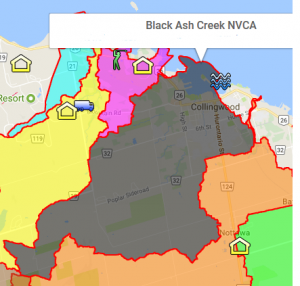-
BLACK ASH CREEK
Black Ash Creek
Black Ash Creek drains an area of approximately 3,000 hectares and empties into the Collingwood harbour. It is the most heavily impacted of the Blue Mountain Watershed’s watercourses and its health is mediocre.
Flow Path
The creek originates from springs above the Niagara Escarpment brow in the vicinity of Castle Glen and Osler Bluff, south of County Road 19. From the brow to Osler Bluff Road, it is heavily forested. The stream bed is rock and gravel and there are few areas where it runs through open lands. As it moves northward towards the harbour, it grows progressively larger with merging branches, some of which are other streams redirected many years ago in Collingwood.
In the 1990s under the Remedial Action Plan (RAP), a project to rehabilitate the water quality in the Collingwood harbour, many improvement projects were carried out to the Creek to improve its water quality such as bioengineering, crib walls and tree planting (some funded by the Watershed Trust) along the banks of the Black Ash to minimize erosion problems. While Black Ash has some water quality problems, the creek has a heavy groundwater input and is designated a cold water fish habitat by the MNR.
Aquatic Life
 Black Ash Creek provides habitat for game fish such as Rainbow Trout, Chinook Salmon and, at its mouth, Smallmouth Bass, Northern Pike, Rock Bass and Yellow Perch.
Black Ash Creek provides habitat for game fish such as Rainbow Trout, Chinook Salmon and, at its mouth, Smallmouth Bass, Northern Pike, Rock Bass and Yellow Perch.
Enjoyment
The best place to view Black Ash Creek is from the walking trail alongside it north of Mountain Road, west of Highway 26 behind Canadian Tire, where the Nottawasaga Valley Conservation Authority and the Blue Mountain Watershed Trust invite the public out to plant trees every April.
Health Check
Before the 1970s, Black Ash Creek consisted of three independent streams: the Black Ash, the Taylor and the Underwood. The Taylor and the Underwood were diverted into the Black Ash for flood control purposes in the Town of Collingwood. The Black Ash was then diverted to the west side of town. This caused damage to the natural formation of the Creek and as a result had a negative impact on water quality.
In the last ten years, the Black Ash has been channelized in Collingwood from Sixth Street to the harbour, again for flood control purposes. The low-flow channel was created in a serpentine formation, thus reducing the negative impacts of the older straight-sided ditch design, as used in the Pretty River.
One area of concern is golf courses that are drained by Black Ash Creek. Golf courses use pesticides, herbicides and fungicides, as well as fertilizers. All of these have a detrimental impact on fish populations and aquatic life in general. See our 2018 Golf Course Pesticide Report for further details.
We believe that Black Ash will continue to improve (since its diversion in the 1970s) if the community takes care of the watershed and continues with conservation projects to help improve water quality and habitat.


